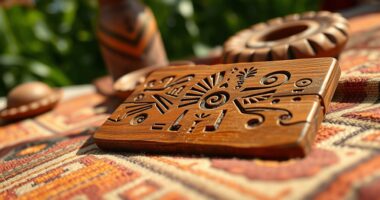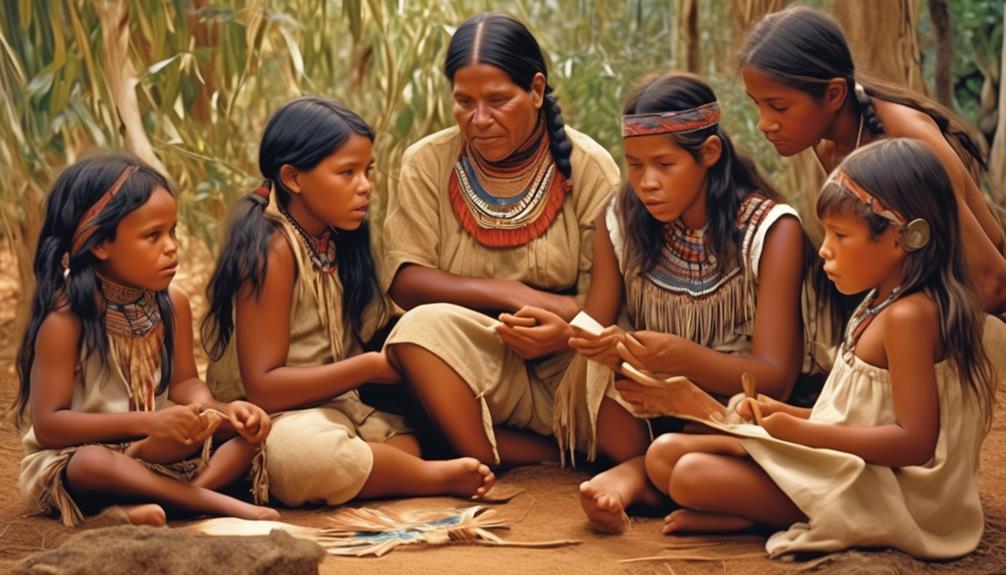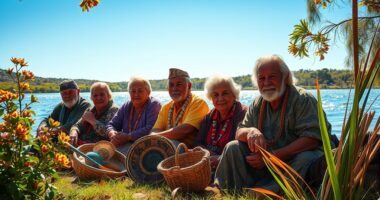Kriol is an Australian creole language born from contact between Indigenous communities and European settlers, blending Indigenous languages with English influences. It symbolizes cultural resilience, blending history, stories, and traditions into a vibrant expression of community identity. As a practical response to a multilingual environment, Kriol reflects adaptation and ongoing cultural revival. If you want to explore how this unique language continues to grow and represent resilience, there’s more to discover behind its fascinating origins.
Key Takeaways
- Kriol developed through contact between Indigenous communities and European settlers, blending Indigenous languages with English influences.
- It serves as a symbol of cultural resilience, identity, and pride for Aboriginal communities in Australia.
- The language reflects a shared history, embodying stories, traditions, and values passed down through generations.
- Kriol plays a vital role in cultural revival, fostering community cohesion and challenging English dominance.
- As a living language, Kriol continues to evolve while representing Australia’s diverse cultural landscape.

Kriol has emerged as a distinctive Australian creole language, blending elements from Indigenous languages, English, and other influences. You might find it fascinating how its language origins trace back to the contact between Aboriginal communities and European settlers. Over time, these interactions led to a new way of communicating that combined vocabulary, grammar, and pronunciation from multiple sources. This blending wasn’t accidental; it was a practical response to the multilingual environment, allowing people from diverse backgrounds to understand each other more easily. As a result, Kriol became more than just a means of communication—it became a symbol of cultural resilience and adaptation.
Furthermore, the development of Kriol reflects the importance of cultural identity in maintaining community cohesion and pride. Your understanding of Kriol’s origins gives you insight into the community’s cultural identity. It’s a language born out of necessity, but it has grown into a powerful expression of identity for many Indigenous Australians. When you hear Kriol spoken, you’re witnessing a living record of history, struggle, and resilience. It’s a way for people to connect with their roots and assert their cultural presence in a world shaped by colonialism and change. The language embodies a collective history, blending traditional Indigenous concepts with influences from English, which was introduced through colonization. This fusion creates a unique cultural expression that’s deeply rooted in the lived experience of its speakers.
By exploring the language origins of Kriol, you also see how language functions as a core part of cultural identity. It’s not just about communication; it’s about belonging and self-expression. For many speakers, Kriol carries stories, traditions, and values that have been passed down through generations. It’s a living reminder of history and community, helping individuals maintain a sense of identity in a changing world. *furthermore*, Kriol’s development reflects a broader story of resistance and pride. Using and promoting the language affirms Indigenous culture and challenges the dominance of English, fostering a sense of empowerment among speakers.
Understanding the roots of Kriol allows you to appreciate its significance beyond mere words. It’s a linguistic badge of cultural identity, representing a community’s history, survival, and ongoing cultural revival. As you listen to Kriol, you’re not just hearing a language—you’re experiencing a vibrant cultural tapestry woven from the threads of Indigenous tradition and colonial influence. This dynamic language continues to evolve, but its core remains a *testament* to the resilience and identity of its speakers. Recognizing its origins helps you see Kriol as more than just a creole; it’s a *vital* part of Australia’s diverse cultural landscape.
Frequently Asked Questions
How Does Kriol Compare to Other Australian Indigenous Languages?
You’ll find that Kriol’s language structure is simpler than many Indigenous languages, blending English with local influences. Unlike traditional Aboriginal languages, which often have complex grammar and unique sounds, Kriol serves as a marker of cultural identity for many communities. It’s more accessible for outsiders, helping foster connection and pride, while still reflecting the rich heritage of Indigenous Australians.
What Are the Main Influences on Kriol’s Vocabulary?
Think of Kriol’s vocabulary like a melting pot bubbling with diverse ingredients. You’ll find language borrowing from English, Aboriginal languages, and other European sources, reflecting rich cultural exchange. This blending shapes Kriol’s words, making it a living record of historical interactions. These influences create a unique linguistic tapestry, where borrowed words tell stories of contact, trade, and shared experiences across cultures in northern Australia.
How Is Kriol Used in Contemporary Australian Media?
You’ll see Kriol featured in contemporary Australian media through slang usage and media representation that highlight Indigenous culture. It appears in TV shows, radio programs, and social media, helping to promote awareness and pride. This presence emphasizes authentic voices and connects audiences with local communities. By integrating Kriol, media fosters cultural understanding, preserves the language, and showcases its vibrant role in Australia’s diverse linguistic landscape.
What Efforts Are Being Made to Preserve Kriol?
You can see efforts to preserve Kriol through language revitalization initiatives and community programs. Local organizations often run workshops, classes, and cultural events that encourage speaking and learning Kriol. These programs aim to keep the language alive for future generations, fostering pride and connection to cultural heritage. By supporting these efforts, you help guarantee Kriol remains a vibrant part of Australia’s linguistic landscape.
Can Non-Indigenous Australians Learn Kriol Easily?
You can learn Kriol, but it depends on your dedication and exposure. Notably, over 80% of non-indigenous Australians find language accessibility challenging, yet many embrace cultural exchange by trying to learn Kriol. Engaging with native speakers and immersing yourself in the community makes it easier. Your effort not only helps preserve the language but also fosters understanding and respect for Indigenous cultures, enriching your cultural experience.
Conclusion
So, now you see, Kriol isn’t just a language; it’s a blazing fire transforming the Australian landscape, forging a new cultural masterpiece out of countless voices. It’s as if the very heartbeat of the outback has spoken, echoing with vibrant stories and wild pride. This creole isn’t just emerging — it’s exploding into a radiant, unstoppable force that will reshape Australian identity forever. Prepare to witness a language that’s as bold and fierce as the land itself.
Mary is a passionate writer who brings creativity and a fresh perspective to our team. Her words have the power to captivate and inspire, making her an essential contributor to our content. Mary’s commitment to storytelling and dedication to promoting Indigenous culture ensures that her work touches the hearts of our readers. We’re fortunate to have her as part of our team.









